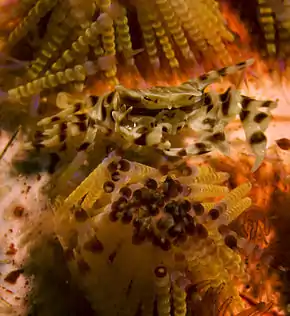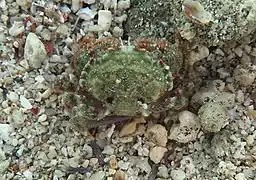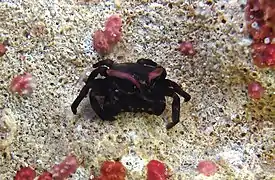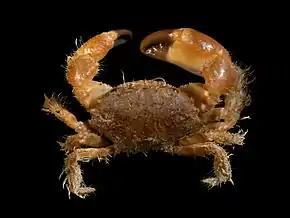Pilumnidae
Les Pilumnidae sont une famille de crabes. Elle comporte près de 400 espèces actuelles et plus de 40 fossiles dans 73 genres dont neuf fossiles.
Liste des sous-familles et genres

Certaines espèces comme Zebrida adamsii vivent en symbiose avec des organismes plus grands.
Selon World Register of Marine Species (25 février 2017)[1] :
- Calmaniinae Števčić, 1991
- Calmania Laurie, 1906
- Eumedoninae Dana, 1853
- Cebudonus Ng, 2014
- Ceratocarcinus Adams & White, in White, 1847
- Echinoecus Rathbun, 1894
- Eumedonus H. Milne Edwards, 1837
- Gonatonotus Adams & White, in White, 1847
- Hapalonotus Rathbun, 1897
- Harrovia Adams & White, 1849
- Permanotus Chia & Ng, 1998
- Rhabdonotus Milne-Edwards, 1879
- Tauropus Chia & Ng, 1998
- Tiaramedon Chia & Ng, 1998
- Zebrida White, 1847
- Zebridonus Chia, Ng & Castro, 1995
- †Santeella Blow & Manning, 1996
- †Viacarcinus Blow & Manning, 1996
- Pilumninae Samouelle, 1819
- Actumnus Dana, 1851
- Aniptumnus Ng, 2002
- Balssopilumnus Števčić, 2011
- Bathypilumnus Ng & Tan, 1984
- Benthopanope Davie, 1989
- Bossapilumnus Števčić, 2011
- Colerolumnus Ng, 2010
- Cryptopilumnus Hsueh, Huang & Ng, 2009
- Danielum Vázquez-Bader & Gracia, 1995
- Eurycarcinus A. Milne-Edwards, 1867
- Glabropilumnus Balss, 1932
- Gorgonariana Galil & Takeda, 1988
- Heteropanope Stimpson, 1858
- Heteropilumnus De Man, 1895
- Lamarckopilumnus Števčić, 2011
- Latopilumnus Türkay & Schuhmacher, 1985
- Leelumnus Mendoza & Ng, 2011
- Lentilumnus Galil & Takeda, 1988
- Lobopilumnus A. Milne-Edwards, 1880
- Lophopilumnus Miers, 1886
- Nanopilumnus Takeda, 1974
- Neoactumnus Sakai, 1965
- Parapleurophrycoides Nobili, 1906
- Pilumnopeus A. Milne-Edwards, 1867
- Pilumnus Leach, 1816
- Priapipilumnus Davie, 1989
- Pseudactumnus Balss, 1933
- Serenepilumnus Türkay & Schuhmacher, 1985
- Serenolumnus Galil & Takeda, 1988
- Takedana Davie, 1989
- Vellumnus Ng, 2010
- Viaderiana Ward, 1942
- Xestopilumnus Ng & Dai, 1997
- Xlumnus Galil & Takeda, 1988
- †Budapanopeus Müller & Collins, 1991
- †Eohalimede Blow & Manning, 1996
- †Eopilumnus Beschin, Busulini, De Angeli & Tessier, 2002
- †Eumorphactaea Bittner, 1875
- †Galenopsis A. Milne-Edwards, 1865
- †Lobogalenopsis Müller & Collins, 1991
- Rhizopinae Stimpson, 1858
- Camptoplax Miers, 1884
- Ceratoplax Stimpson, 1858
- Cryptocoeloma Miers, 1884
- Cryptolutea Ward, 1936
- Itampolus Serène & Peyrot-Clausade, 1977
- Lophoplax Tesch, 1918
- Luteocarcinus Ng, 1990
- Mertonia Laurie, 1906
- Paranotonyx Nobili, 1906
- Paraselwynia Tesch, 1918
- Peleianus Serène, 1971
- Pronotonyx Ward, 1936
- Pseudocryptocoeloma Ward, 1936
- Pseudolitochira Ward, 1942
- Rhizopa Stimpson, 1858
- Rhizopoides Ng, 1987
- Ser Rathbun, 1931
- Typhlocarcinops Rathbun, 1909
- Typhlocarcinus Stimpson, 1858
- Zehntneriana Ng & Takeda, 2010
- Xenopthalmodinae Števčić, 2005
- Xenopthalmodes Richters, 1880
- †Arges De Haan, 1835
 Actumnus digitalis
Actumnus digitalis_002.jpeg.webp) Aniptumnus vietnamicus
Aniptumnus vietnamicus_003.jpeg.webp) Balssopilumnus boletifer
Balssopilumnus boletifer_003.jpeg.webp) Ceratoplax margarita
Ceratoplax margarita Echinoecus pentagonus
Echinoecus pentagonus_001.jpeg.webp) Eumedonus niger
Eumedonus niger_001.jpeg.webp) Eurycarcinus natalensis
Eurycarcinus natalensis_001.jpeg.webp) Gonatonotus nasutus
Gonatonotus nasutus_(16057833218).jpg.webp) Harrovia elegans
Harrovia elegans_002.jpeg.webp) Heteropanope tuberculidens
Heteropanope tuberculidens.jpeg.webp) Heteropilumnus sp.
Heteropilumnus sp..jpg.webp) Lobopilumnus agassizii
Lobopilumnus agassizii.jpg.webp) Pilumnus marshi
Pilumnus marshi_001.jpeg.webp) Rhabdonotus xynon
Rhabdonotus xynon_002.jpeg.webp) Takedana eriphioides
Takedana eriphioides Tiaramedon spinosum
Tiaramedon spinosum.jpeg.webp) Viaderiana kasei
Viaderiana kasei
Références taxinomiques
- (en) Référence World Register of Marine Species : taxon Pilumnidae Samouelle, 1819 (+ liste genres + liste espèces)
- (en) Référence Paleobiology Database : Pilumnidae Samouelle 1819
- (fr+en) Référence ITIS : Pilumnidae Samouelle, 1819
- (en) Référence Animal Diversity Web : Pilumnidae
- (en) Référence Catalogue of Life : Pilumnidae (consulté le )
- (en) Référence NCBI : Pilumnidae (taxons inclus)
Référence
- Samouelle, 1819 : The entomologist’s useful compendium; or an introduction to the knowledge of British insects, comprising the best means of obtaining and preserving them, and a description of the apparatus generally used; together with the genera of Linné, and the modern method of arranging the classes Crustacea, Myriapoda, Spiders, Mites and Insects, from their affinities and structure, according to the views of Dr. Leach. Also an explanation of the terms used in entomology; a calendar of the times of appearance and usual situations of near 3,000 species of British insects; with instructions for collecting and fitting up objects for the microscope. London. p. 1-496 (texte original).
Sources
- Ng, Guinot & Davie, 2008 : Systema Brachyurorum: Part I. An annotated checklist of extant brachyuran crabs of the world. Raffles Bulletin of Zoology Supplement, n. 17, p. 1–286.
- De Grave & al., 2009 : A Classification of Living and Fossil Genera of Decapod Crustaceans. Raffles Bulletin of Zoology Supplement, n. 21, p. 1-109.
Notes et références
- Portail de la carcinologie et des crustacés
- Portail de la biologie marine
Cet article est issu de Wikipedia. Le texte est sous licence Creative Commons - Attribution - Partage dans les Mêmes. Des conditions supplémentaires peuvent s'appliquer aux fichiers multimédias.
